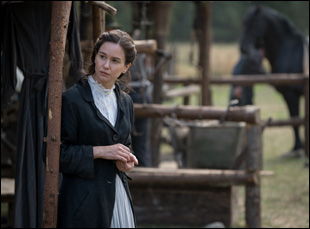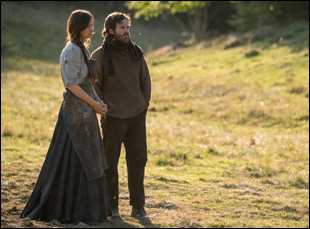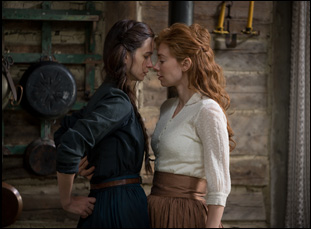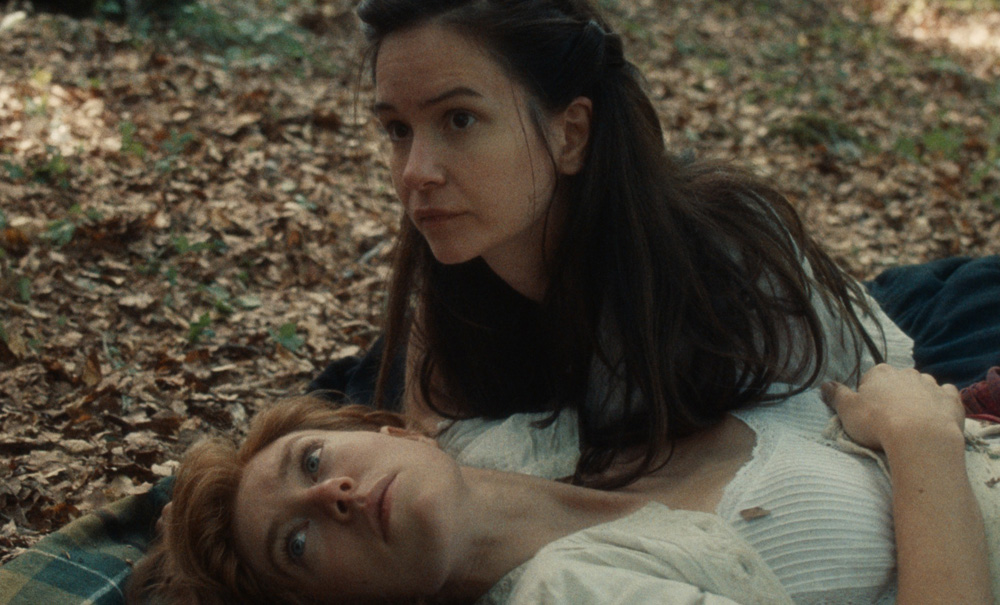Mona Fastvold had reached a donnybrook on a film she was writing for herself to direct when she was approached with the script for “The World to Come,” Ron Hansen and Jim Shepard’s adaptation of Shepard’s short story about a lonely housewife in the largely unsettled territory of upstate New York in the 1850s, having little company but her husband until a new couple moves in to tend to the land next to theirs. The screenplay had been looking for a home for some time, having been commissioned by Casey Affleck in the wake of his work on the adaptation of Hansen’s “The Assassination of Jesse James by the Coward Robert Ford” and just as it was seemed as if it was waiting for the right person to direct it, Fastvold could feel its pull towards her.
“I loved both the authors and it felt like something that I knew how to do,” recalls Fastvold. “It’s a weird thing. Sometimes you come across a story, either it’s a novel or a short story and very, very rarely a screenplay and you feel like, “Oh, this is home to me. I know how to put this together and create something exciting out of this.” There were some images that I felt really compelled to create.”
More so than in most cases, that vision was necessary when images were the primary language Fastvold had to work with when so little of what happens in “The World to Come” is communicated through words. There are plenty of them as you listen to Abigail (Katherine Waterston) sharing her innermost thoughts for the benefit of the audience, but even in her own mind, you sense she might be censoring herself just a bit given the sentiment of the times when thoughts about her salty husband Dyer (Affleck) could be seen as disloyal or the interest she takes in Tallie (Vanessa Kirby), the new neighbor, unnatural. As bitter and crushing as the cold that arrives in winter, Abigail is faced with the constant chill of suppression in a society that so throroughly favors men, making it impossible to leave a marriage where both she and her partner are unhappy or openly pursue the path her heart leads her on.
Yet “The World to Come” boldly expresses what Abigail can’t time and again, anchored by strong performances from a fierce quartet of actors that also includes Christopher Abbott as Tallie’s husband and brought to vivid life by Fastvold’s shrewd touches, from the film’s use of Abigail’s voiceover to pacing in line with her emotional currents. At the suggestion of production designer Jean-Vincent Puzos, the director set up camp in the farming village of Dâmbovicioara in the Carpathian Mountains of Romania to stand in for the barren countryside of New York, and triumphantly bends nature to her will as her lead character can’t, summoning seasonal changes that reflect Abigail’s mood and harnessing darkness to make any light that cracks through particularly brilliant, giving a sense of her isolation when there’s nothing but open range in front of her.
With the film arriving in virtual cinemas this week following stops at the Venice and Sundance Film Festivals, Fastvold spoke about how she embraced the challenges of recreating a period of great restraint to ultimately make such an exuberant romance.

It was a code I had to crack. That’s how it felt. There’s a ton of voiceover in the screenplay, even more than ended up in the film, and I loved it, but voiceover is kind of a don’t do for filmmakers. It can go badly. Some people might not enjoy it, but I like a good voiceover, and this was very specific. It was supposed to be not a voiceover where I was telling you or guiding you through the story, but an internal voice, like Abigail’s private thoughts, so I thought “how do we find that voice and how do we make it that intimate? Like how can I create an almost ASMR type of experience out of this whisper diary?”
I worked a lot on that and I really wanted to have it woven into the film rather than have it slapped on top, so Katherine would do scratch recordings almost everything before we started shooting. On set, we’d go and record a piece, I would play it and time a tracking shot to the length of a special entry and really work it into the rhythm of it all, so it wasn’t like, “Oh, I have to make room for it later on” or “I’m going to write in a new line to help me with some editorial problem.” I didn’t really use it in that way at all. In that way, it didn’t really change much, but I did experiment with some things structurally like you usually do in the edit – I actually went back to the short story and found pieces that I could put back in to the movie – and in those places, the voiceover changed.

I do approach directing in that way a lot. I like to do long takes and I don’t like to edit much unless it’s really motivated by a beat change or movement. I love having movement guide camera movement and not just do cool shit, just for the sake of it. (laughs) Even though I like to do some cool shit too, but I want it to be motivated by something, by saying “Look at this” or “I’m taking you somewhere else.” So finding that choreography is challenging when you have little time and not that much time to rehearse. I usually try and rehearse before we start shooting, like six in the morning. We’ll rehearse some scene for the day, the next day, or at the end of the day, with my DP present, then going through saying, “This is where I wish to have a change, this is the dynamic if I place you here…”
It’s like if you look at paintings – they can be extremely moving to see someone in the left corner of the frame with empty space next to them and their neck and their back. That can convey just as much isolation and loneliness as someone’s face. So sometimes [I get the question] from actors, “Why?!?! Everything’s happening here.” (laughs) But I say, “No, I see it in your back and your shoulders as much, or your hands or how you place yourself in the furniture.” I think that comes from my background in dance and movement that I like to approach filmmaking in that way.

Because of the period obviously, you wouldn’t turn on all the gaslamps and light all the candles because you’re rationing them, so it was a luxury at the time, and I thought for the night and the exterior scenes, [I wanted] to go as dark as we could or be dangerously on the edge of what we could do with celluloid and just feel those very small specific light sources, and have that be almost painterly in that way. That was something that Andre Chemetoff, my [cinematographer] and I tried to achieve as much as possible to be really be bold and dare to go dark and for it not to feel very lit in those scenes, which [ironically] demands a lot of lighting to be able to do that.
When you’re in Romania and I understand there’s a hike to set, did that sense of isolation of filming a movie bleed into the feeling of it?
It always helps with concentration to be isolated like that. Everybody’s eating together and living and breathing the movie for the time you’re there, and especially when you have a tight schedule, it’s really important all of a sudden. You do start finding a groove a little bit faster because you don’t go home and deal with your normal chores and everything, so being on a remote location helps with that. Also the surroundings in Transylvania just transports you. It’s incredibly beautiful. We were surrounded just by farmers. There’s no luxury around. You give up the food items that you long for — I think the little things that you miss help too. [laughs]
“The World to Come” opens in theaters on February 12th and available on demand on March 2nd.




